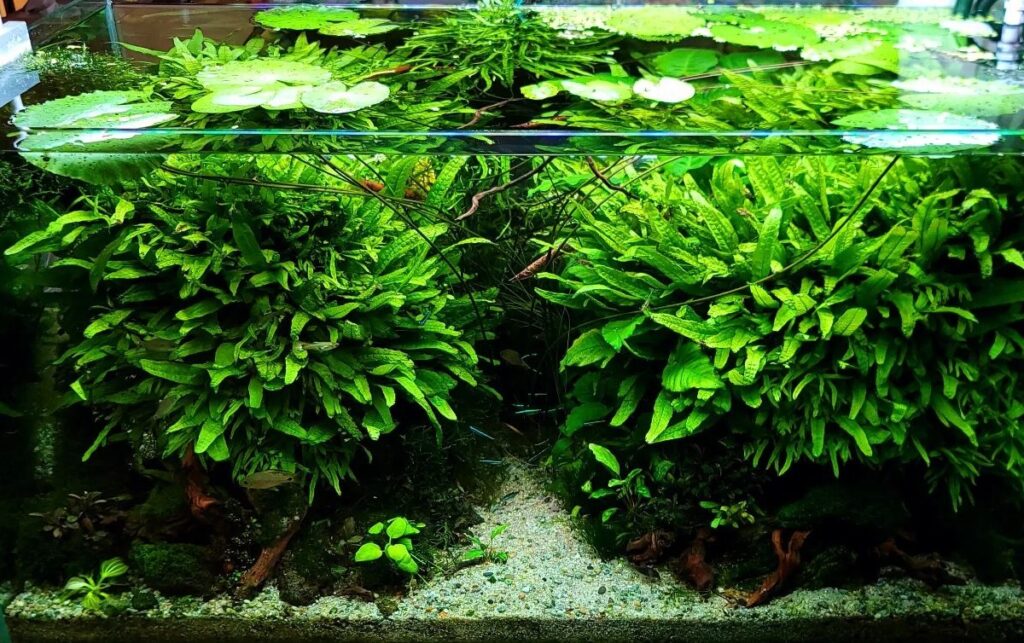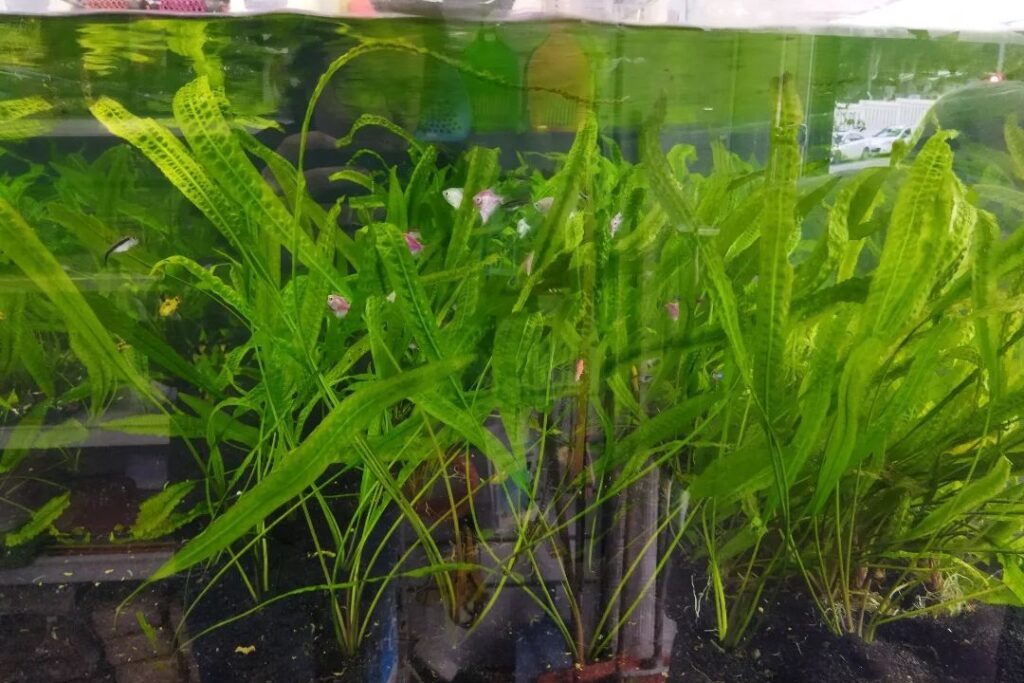Are you looking for a way to add some color and life to your blackwater aquarium? Then you’re in luck! With the right plants, you can transform your tank into a beautiful underwater oasis. In this article, we’ll look at seven of the best plants for blackwater aquariums—ones that will thrive in low-light conditions and won’t be affected by the acidic water pH. So if you’re ready to bring some greenery into your aquarium, keep reading!

Contents
Can You Have Plants in a Blackwater Aquarium?
While it may seem counterintuitive, yes, you can absolutely have some form of vegetation in a blackwater tank. Different plants will require different lighting requirements and water chemistry adjustments to survive, so it is important to consider the type of plant that best suits your tank setup before introducing any flora.
You should also consider substrate choices and fish compatibility since certain plants will do better than others with specific kinds of fish. Additionally, take into account the maintenance needs of each kind of plant so they stay healthy and vibrant in your aquarium environment. With a bit of careful consideration and planning, you can create a beautiful blackwater planted tank that will provide a great home for both aquatic plants and fish alike.
Best Plants For Blackwater Aquarium
Java Fern

Java fern is a great choice for those looking to add an interesting yet easy-to-care-for plant to their tank. It’s a popular aquarium plant due to its low maintenance and unique appearance, making it a favorite among aquarists of all levels. There are many different types of java ferns, so you can choose the one that best suits your blackwater aquarium setup.
Java fern care is relatively simple; they only require occasional trimming, partial water changes, and a bit of light. In addition to being easy to take care of, java ferns also offer several benefits in the form of filtration and oxygenation. They act as natural filters that remove excess nutrients from the water while providing plenty of oxygen for fish and other aquatic life. Plus, they help prevent algae growth by competing with algae for nutrients in the water column. Lastly, propagating new Java ferns is easy – simply divide existing clumps into smaller sections and replant them elsewhere in your tank! With proper care and attention, these plants will reward you with stunning foliage and lush growth year after year!
Nymphaea Stellata
You’ll be mesmerized by the beauty of Nymphaea stellata, a beautiful water lily with star-shaped white flowers that will bring life to any tank! This plant is perfect for blackwater aquariums because it doesn’t require a lot of lighting and can easily adapt to different water parameters.
When it comes to Nymphaea Stellata care, it’s important to note that it’s best planted in substrate or rock wool as roots are delicate and need support. Lighting requirements for this plant are low, making it ideal for tanks without too much direct light. It’s also easy to propagate; simply cut off the stem at the nodes and replant them elsewhere in your tank. Lastly, when aquascaping with this plant consider layering multiple specimens near each other on one side of your aquarium and combining them with other plants like Java moss or Cryptocoryne species.
Anubias

Anubias is an incredibly versatile aquatic plant that can thrive in a variety of water conditions, making it perfect for any aquarium setup! This makes Anubias a great choice for blackwater tanks because its tolerant of low lighting requirements, a wide range of substrate types, and water parameters such as pH and hardness. It also has minimal fertilizer needs and doesn’t require frequent trimming. Its slow-growing nature ensures that it won’t take over the tank but will still provide plenty of cover for fish.
Anubias provide vibrant, lush foliage to any aquarium while still being very easy to maintain. You’ll quickly notice its unique texture and shape which adds diversity and visual appeal to your tank. Plus, its robustness means that it can survive even in less-than-ideal environments due to its slow growth rate and hardy nature. With proper care, you can enjoy this beautiful plant in your blackwater aquarium for years to come!
Bucephalandra
Bucephalandra is another great choice for a low-maintenance, visually stunning addition to your tank; its hardy nature and slow growth rate mean it’ll stick around. This plant does best in temperatures between 72-86°F, planted in substrates with a neutral pH level of 6.5-7.5 and lighting levels that are not too intense.
Although Bucephalandra can survive in varying water flow conditions, it’s important to remember that this species prefers moderate currents for optimal health. With the right substrate choice and proper monitoring of water temperature, lighting levels, and pH levels, you can ensure that your Bucephalandra will thrive in your blackwater aquarium!
Cryptocorynes

Moving on from bucephalandra, let’s discuss cryptocorynes! Cryptocorynes are a species of aquarium plants that are an excellent choice for blackwater aquariums. They are relatively easy to care for and can tolerate a wide range of water parameters. When it comes to cryptocoryne care, you should start by ensuring the water is soft and acidic with a pH between 5 and 7. Additionally, since they prefer slow-moving currents, make sure your filter isn’t creating too much flow in the tank. You may also need to provide additional lighting if the natural sunlight isn’t enough.
Cryptocoryne propagation can be done through division or by planting the stem cuttings directly in the substrate. To help your cryptocorynes thrive, you should fertilize them with liquid fertilizer once a week and occasionally add root tabs to ensure optimal nutrient uptake. The main diseases that affect cryptocorynes are bacterial infections which can be treated with antibiotics or copper sulfate solution. With proper care and maintenance, your cryptocorynes will be beautiful additions to your blackwater aquarium!
Salvinias
You’ll love having Salvinias in your tank, as they’re easy to care for and can thrive in a variety of water conditions. Salvinia propagation is simple – just separate the rooted plants into two or more parts and replant them in the substrate. You can also propagate by cutting off a small piece of the plant and planting it elsewhere. Fertilization isn’t necessary for these plants but if you wish to fertilize then use a liquid fertilizer once every few weeks.
Salvinias offer several benefits for your blackwater aquarium, including oxygenating the water, helping keep nitrates down and providing food for grazing fish. They don’t require much light so they’re ideal if you have low lighting levels in your tank. The only pests that may feed on salvinias are snails – luckily these can be easily removed with traps or tweezers! With proper care, they will quickly fill out any tank with their lush green foliage and provide lots of surface area for beneficial bacteria to colonize.
Najas Indica
If you’re looking for a low-maintenance plant that’s full of lush foliage, Najas Indica is the perfect choice! This aquatic plant is native to India and loves living in a blackwater aquarium. Its water temperature requirements are between 68 – 86°F, making it well-suited for tropical fish tanks. When fertilizing your tank with Najas Indica, follow the general guidelines of most other plants: use liquid fertilizer once every two weeks or so.
Planting techniques are simple: simply place them in shallow areas of your tank and they will spread out quickly. As far as lighting requirements go, this plant prefers medium to high light intensity with at least 6 hours per day of direct sunlight exposure. Lastly, Najas Indica can handle moderate water flow but doesn’t require it for survival; too much can cause damage to its leaves.
Conclusion
You can have plants in your blackwater aquarium, and it’s a great way to give your fish more places to explore and hide. These seven plants are perfect for a blackwater setup; they’re easy to care for, provide natural filtration, and look great too. With the right research and preparation, you can create an amazing blackwater environment that will be the envy of all your fish-keeping friends! So get out there and start creating a truly unique aquatic paradise that you can enjoy for years to come.
